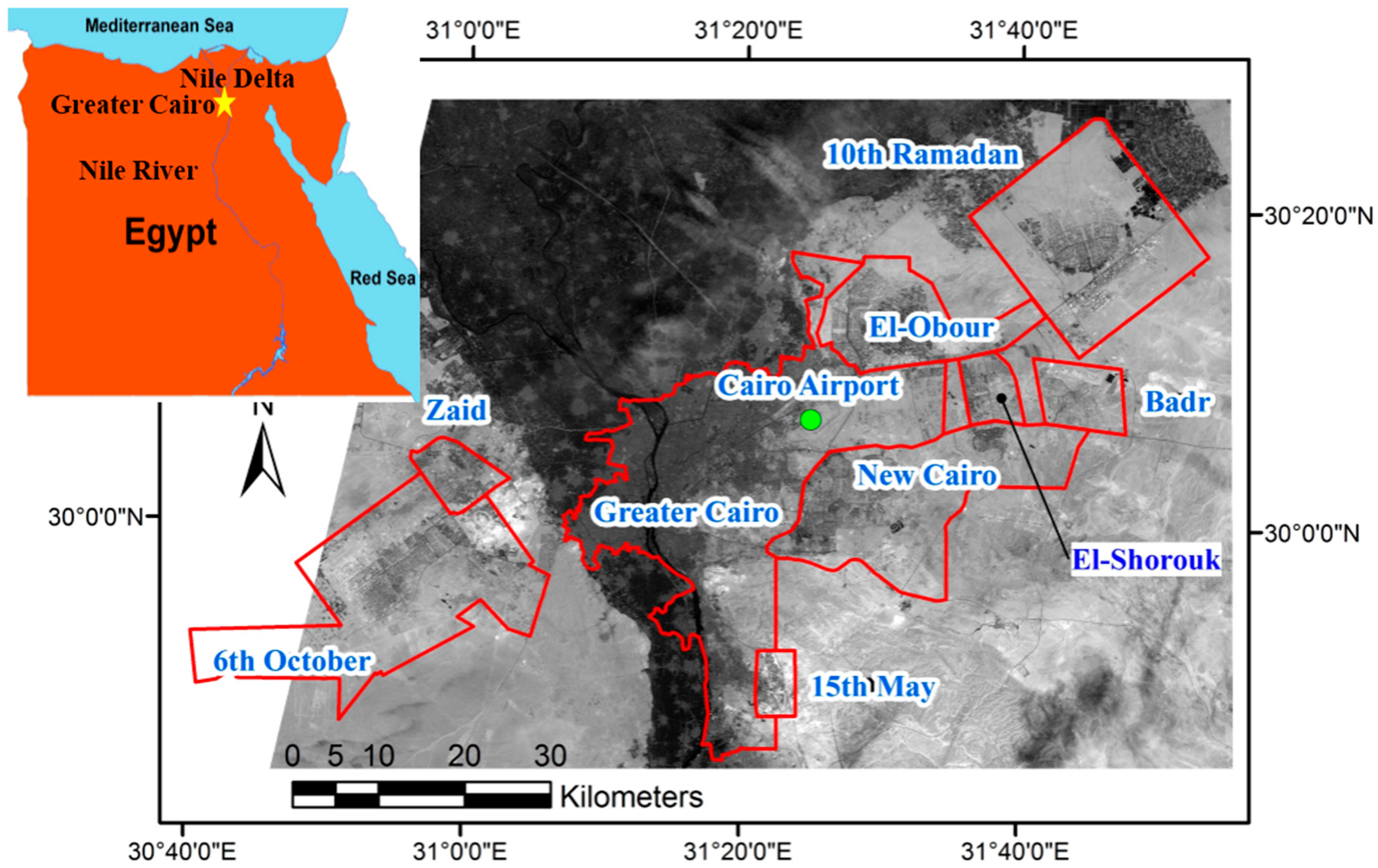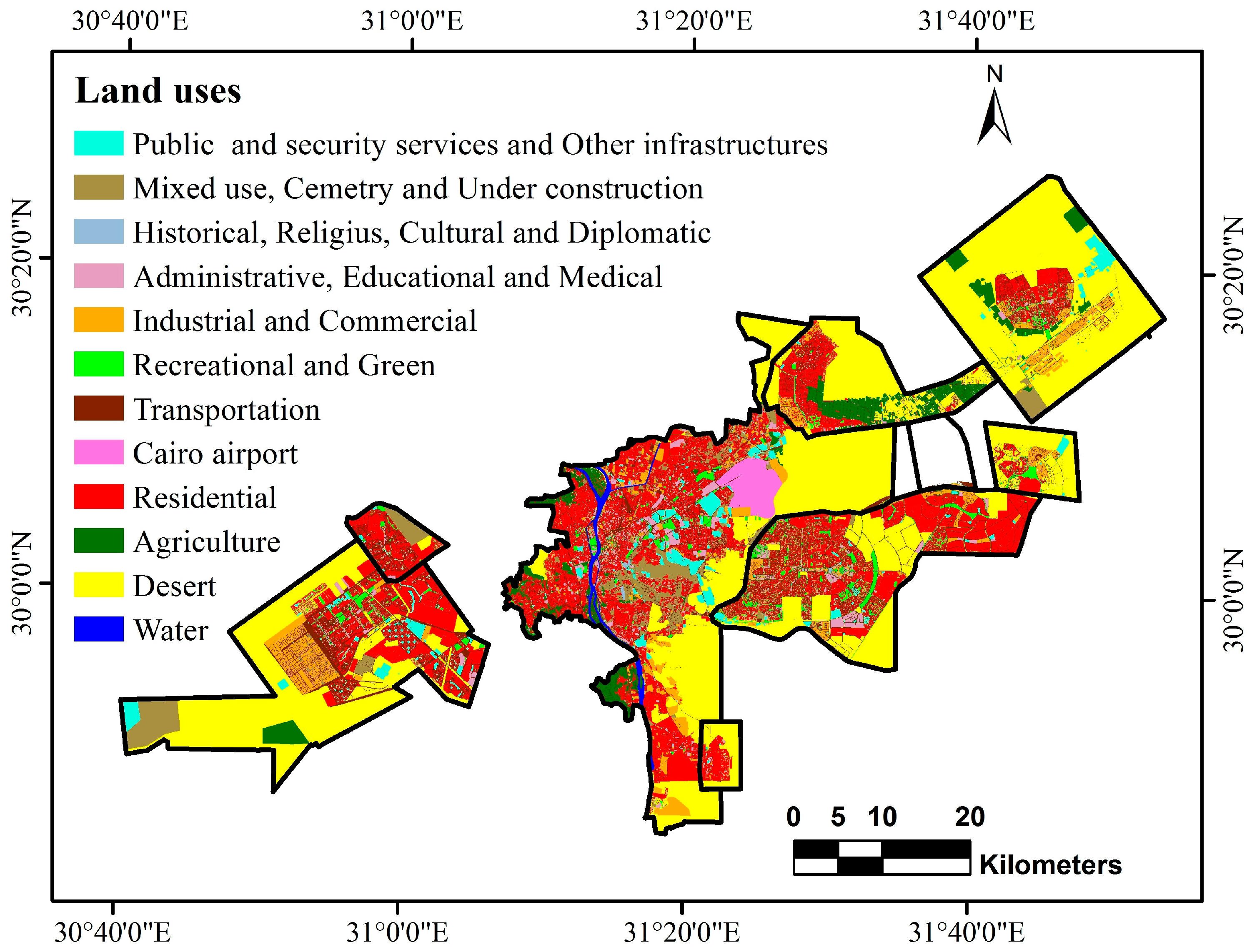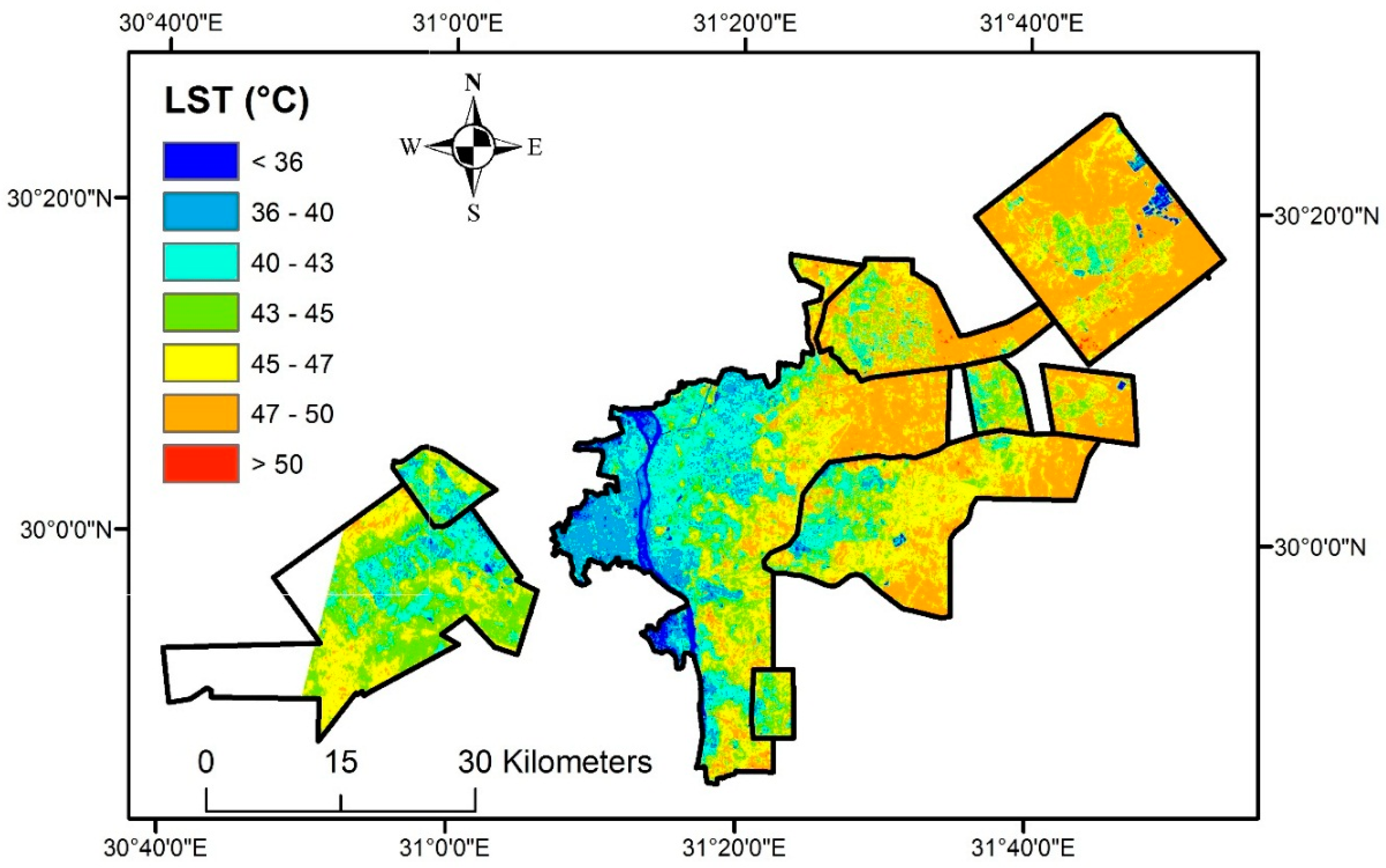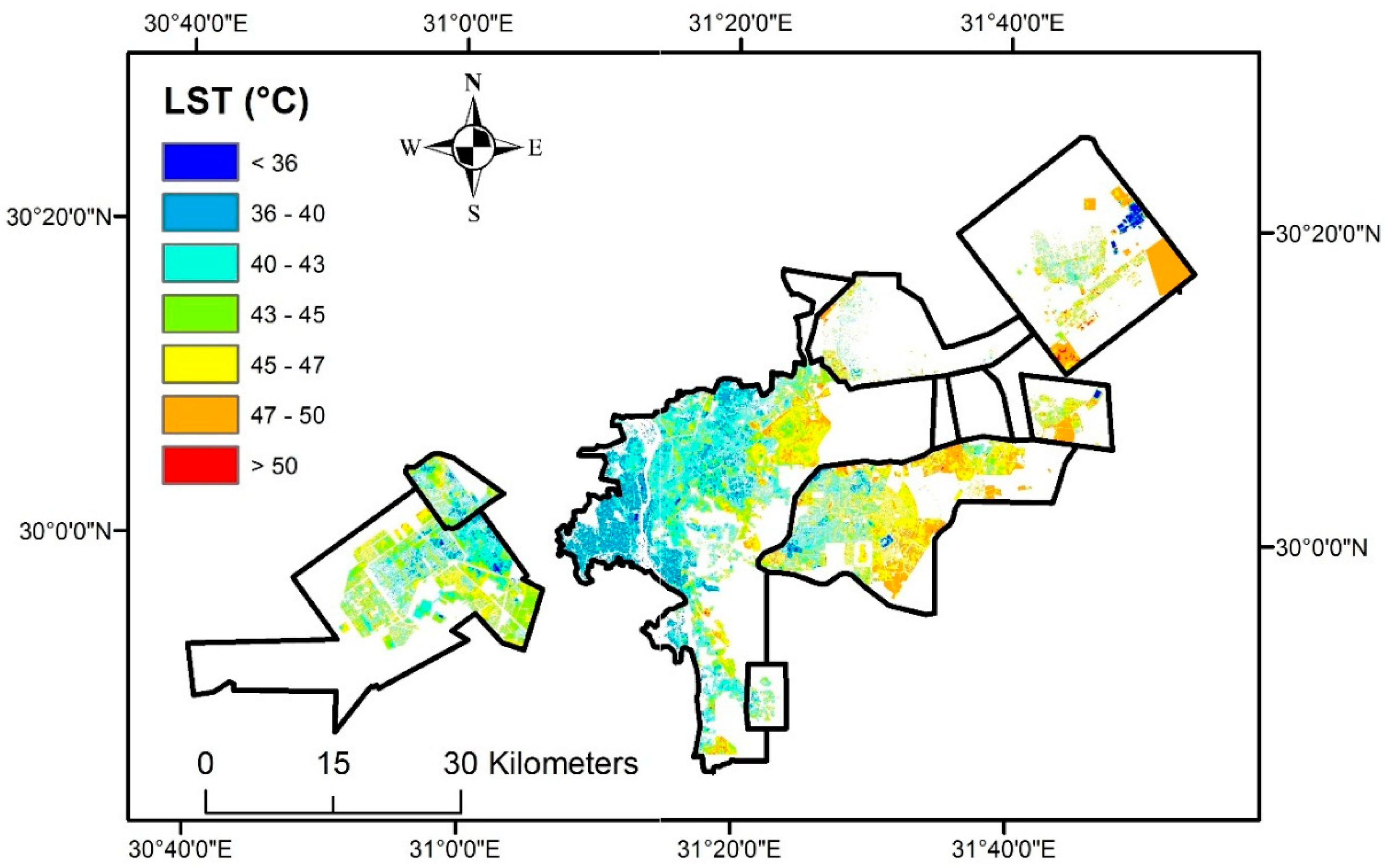1. Introduction
In general, Urban Heat Island (UHI) is defined as significantly warmer air temperature in an urban area compared to its surrounding non-urban area, as a result of urbanization. During daytime, different factors (e.g., thermal properties of building materials, blocking of wind by buildings, lack of latent heat from evapotranspiration, lower albedo) cause a change in the energy budget of the urban area, leading to higher surface temperatures, called surface urban heat island (SUHI). Although the surface temperature in an urban area can have significant difference to its surrounding rural areas during daytime, the largest air temperature difference is observed after sunset and during the night [
1]. Heat stored by surfaces and features in urban areas during the daytime is released at nighttime, and it has a lot of influence on the development of atmospheric heat island at nighttime. Hence, daytime SUHI can be an indicator for occurrence of nighttime atmospheric heat island in urban areas.
The population of the world that is living in urban areas is increasing. In 1950, around 29% of the global population lived in urban areas. This proportion had grown to 47% by the year 2000, and it is predicted that this will grow to 69% by the year 2050 [
2]. Thus, urban areas are continuously growing [
3], and the number of people exposed to temperature and heat stress impact is expected to increase [
4]. The combined effects of growing urbanization and demographic change (e.g., population aging) increase both the risk of heat stress, and its mortality rates [
5,
6,
7,
8]. The relationship between elevated temperature and mortality has been reviewed by Basu and Samet [
9]. The average heat-related mortality in Cairo during summer (June–August) is about 300 persons [
10]. Strzepek and Smith [
11] showed that the heat-related mortality rate in Cairo is about 4.5 per 100,000 people. The mortality rate in Cairo during summer (June–August) increases rapidly as the temperature increases [
10], and 4 °C warming can increase the heat-related mortality rate from 4.5 to 19.3 per 100,000 people [
11]. Most studies into the relationship between temperature and mortality have shown that elderly people are most greatly affected by the increase in temperature, because of a reduced ability for thermoregulation [
12,
13]. Children are another group sensitive to temperature [
14], as their bodies lack sufficient thermoregulation capacity [
15]. UHI exerts significant thermal stress on vulnerable people during warm conditions [
16], and can seriously affect energy consumption in hot conditions [
17]. In the near future, the problem of the urban heat island may become a more important issue than that of global warming, as the rate of urban warming may be faster than the rate of global warming [
18].
Urban areas in temperate zones often show SUHI during the daytime. Cities in deserts, however, often show different thermal behaviors, and sometimes show surface urban cool island (SUCI) [
19]. The surrounding areas of Kuwait city are desert, and the built-up areas in Kuwait city have had lower temperatures than its surrounding areas. [
20]. Lazzarini et al. [
21] found daytime SUCI in Abu-Dhabi, UAE, and Frey et al. [
22] found daytime SUCI in Dubai, UAE.
Although UHI studies have been carried out in many American, European and Asian urban areas, there are only a few studies on UHI in African cities [
23]. Given the impact of UHI, it is necessary that it be investigated in African urban areas, especially during the warm seasons in mega cities.
Since the advent of thermal remote sensing technology, it has been possible to estimate SUHI in urban areas. Rao [
24] utilized remote sensing for SUHI investigation. Gallo et al. [
25] reviewed the urban heat island estimation techniques using satellite data, and Voogt and Oke [
26] reviewed studies that have employed thermal remotely sensed data for the investigation of urban climate.
In recent decades, Landsat-TM & ETM+ (Thematic Mapper & Enhanced Thematic Mapper Plus) data have been widely used for land surface temperature (LST) and urban heat island studies, and many studies have demonstrated the potential of Landsat data for surface temperature estimation (e.g., [
16,
27,
28,
29,
30,
31,
32,
33,
34,
35,
36,
37,
38,
39,
40,
41,
42,
43,
44]).
There is no special threshold to define the urban heat island, and a reference is necessary for the estimation of UHI. Pre-urbanization observations are ideal references for the estimation of UHI [
45], but these observations are often not available. Hence, rural or non-urban references have often been employed in UHI studies. The urban–rural contrast is different to the contrast between the pre-urban and current urban temperature. Rural areas are defined as the non-urban areas that surround an urban area. These areas can, however, include agricultural land, and other areas that have been altered by human activity.
The complexity involved in selection of rural references for estimation of SUHI intensity led to develop a new definition of SUHI that excludes rural references and it is called SIUHI (Surface Intra-Urban Heat Island) [
16]. In this approach, the thermal references are the various temperature threshold above the spatial mean of LST within urban area [
16].
In this study, a comprehensive study on the daytime SUHI in Cairo and its new towns during the summer was carried out using Landsat TM & ETM+ data. The previously stated approaches were utilized for SUHI evaluation in these case studies.
Previous studies have demonstrated that temperature in desert areas is related to the time of day [
21,
46,
47]. Lazzarini et al. [
21] estimated the daily surface temperature in summer using MODIS-Terra and MODIS-Aqua at two different times, in Abu Dhabi, two new built-up areas around Abu Dhabi (Mussafah and Khalifa City), and a desert area. They showed that the relative LST differences at two different times at daytime are significantly different. Although Mussafah and the desert area had similar LST from 9:00–10:00 a.m. UTC, the desert area showed higher LST than Mussafah from 6:00–7:00 a.m. UTC. Furthermore, Frey et al. [
47] compared the surface temperature of an urban station in Cairo with a suburban-agricultural station and a suburban-desert station for a period from November 2007–February 2008. They demonstrated that the surface temperature behavior in the studied stations could be completely different in the afternoon, despite showing similar behavior in the morning. Therefore, the findings of this study are only valid in the morning at about 8:00 a.m. UTC (Time of acquisition of Landsat images).
Furthermore, although some studies have assumed that the relationship between land cover types and surface temperature within the study area is spatially stationary (e.g., [
48]), it has been found that this relationship can be spatially non-stationary (e.g., [
49]) and it is also sensitive to the spatial resolution [
50]. In this study, spatial non-stationary behaviors are not investigated and only the average of this non-stationary relationship (bulk effect of built-up area (land cover type)) is statistically evaluated using only one spatial resolution (spatial resolution of Landsat images).
This study attempts to answer the following main questions:
- -
Is there any significant daytime LST difference during summer, between the urban areas of Cairo and its new towns, and their built-up areas?
- -
Is there any significant difference between the type of probability density functions of daytime LST in the urban areas, and their built-up areas?
- -
What is the relative intensity of spatial variations of daytime LST in Cairo and its new towns? How can it be interpreted?
- -
Is there any temporal trend in daytime LST of Cairo and its new towns resulting from urbanization?
- -
Can SIUHI approach be considered as a reliable alternative to surface urban heat island studies?
- -
What are the drawbacks of the utilization of rural references in SUHI studies?
- -
How can the ideal approach (pre-urbanization approach) be implemented in the study areas?
- -
Is there any daytime SUHI in Cairo and its new towns during summer?
2. Case Studies
Cairo is the capital city of Egypt. It is located in the southern part of Nile Delta [
51]. Greater Cairo Metropolitan has the largest urban area in Africa and the eleventh biggest city in world. The main urban area of Greater Cairo is composed of the urban parts of three administrative authorities (Cairo, Giza and Al-Qalubiya), which is named locally as “Cairo” and accommodates a population of about 20 million [
52]. In this paper, “Cairo” refers to Greater Cairo main urban area, which its area and perimeter are about 880 km
2 and 260 km, respectively. In Cairo, streets are covered in asphalt, and the type of surface material in this area is mostly desert sand. Cairo has an arid climate, and is located in a relatively flat area, although there are some hills in its eastern and southeastern parts. According to the Köppen climate classification [
53], Cairo has a hot desert climate. The average daily mean, maximum and minimum temperatures in Cairo are 13.8, 19.7 and 8.8 °C, in January, and 27.9, 34.9 and 22.3 °C, in July, respectively. Annual rainfall in Cairo is about 20 mm and it is almost completely without rain from April to September. The prevailing winds are Northern, North Western and Western winds, with percentage of occurrence 31.8%, 12.9%, 12.8%, respectively [
51].
Urbanization and industrialization increased very rapidly in Cairo in the second half of the 20th century [
51], and the built-up area in Greater Cairo increased by about 31.7% from 1986 to 1999 [
52]. As the population of Cairo increased, large areas of arable land were converted to residential uses. In 1969, Egyptian president, Gamal Abdel Nasser, proposed a master plan for the creation of satellite cities in the desert surrounding Cairo. In this paper, New Towns (NT) refer to satellite cities. These new towns could control Cairo’s growth and provide alternative sites for urban development [
54]. Although Nasser died shortly after the suggestion of this plan, his successor, Anwar Sadat, suggested an extensive new town program in 1974. Over the past four decades, the ideas for construction of new towns around Cairo have been implemented [
54]. The eight new towns founded near Cairo, are presented in
Table 1 with their areas and date of construction.
Figure 1 depicts the position of Cairo in relation to these new towns.
5. Conclusions
The results of statistical tests demonstrate that the new towns, and their built-up areas, have about 2 K higher land surface temperature than Cairo and its built-up areas. There is no significant difference between the probability density functions of mean LST datasets of the studied urban areas and their built-up areas. These results show that there is no daytime SUHI during summer in Cairo and its new towns. The mean land surface temperature in the studied areas had normal probability density functions, which were retrieved and presented. According to the results of Mann–Whitney U-test, spatial variations of land surface temperature in Cairo are greater than in new towns and also in the built-up areas in Cairo. Unlike new towns, or Cairo’s built-up areas, Cairo is composed of miscellaneous land covers with different thermal properties, and effects. The surface and landscape difference between Cairo and its new towns is the major factor in the difference between the daytime land surface temperature of new towns and Cairo during summer. Furthermore, it was demonstrated that the intensity of variations of land surface temperature in the built-up areas of Cairo and its new towns have significant difference; accordingly, and the thermal effects of land covers and construction materials and techniques in NT and Cairo can be significantly different. Test of trend showed that the land surface temperature in Cairo, new towns, and their built-up areas, has been constant during the last three decades, and urbanization has had no significant effect on surface temperatures (No SUHI/SUCI effects). Utilization of pre-urbanization observations approach (ideal approach) showed that there is no daytime SUHI/SUCI during summer in the new towns, and construction activities in the study areas have no cooling or heating effect on surface temperature. However, the power of performed statistical tests in this case was low because of the small sample sizes (sample sizes: 5 and 7 samples). Utilization of rural observations approach showed lower temperature in Cairo than in its surrounding areas during morning, which can be interpreted as the oasis effect. Although the other rural areas in the northern and southern parts of Cairo can be employed for evaluation of urban–rural difference, it is clear that the selection of suitable rural references in SUHI studies is an important and complicated task, and this approach can lead to misinterpretation as the urban–rural difference approach is highly dependent on the characteristics of the selected rural areas, especially in urban areas in desert. Consequently, this approach seems to be an unreliable technique for the study of SUHI in desert city areas (e.g., Cairo), which have significant surface and landscape difference with their surrounding areas. Utilization of SIUHI approach showed that the mean SIUHI and area of hot spots in new towns have significant temporal trend. The presented trend by SIUHI technique is related to the temporal change of variance of probability density function of surface temperature. Hence, the mean SIUHI and area of hot spots are not a representative technique for surface temperature trend in urban areas. SIUHI technique is only able to highlight the changes of standard deviation of surface temperature and this technique is not able to detect mean surface temperature changes in an urban area, which is due to urbanization.
It should be noted that the findings of this study are only valid in the morning at about 8:00 a.m. UTC (Time of acquisition of Landsat images) during summer.











